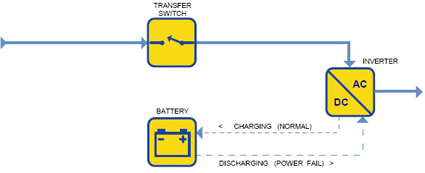UPSes To The Rescue
UPS Types
A standby UPS filters the electric current and switches to the battery backup in case of a power failure (Source: APC Media).
There are various implementations for uninterruptible power supply units:
- Standby UPS (entry-level);
- Line-Interactive UPS (entry-level, mainstream);
- Standby-Ferro UPS (mainstream to high-end);
- Double-Conversion Online UPS; Delta Conversion Online UPS (high-end, industrial).
A standby UPS will only switch to the battery if the main power fails, which is why it is called standby. Most commercially-used UPS solutions are based on a line-interactive design. This means that the AC/DV inverter, which is used to charge the battery and to provide the failover power, is always connected to the active circuit. The other designs include a transformer for maximum reliability and filtering (Standby-Ferro, at the expense of efficiency). They implement a rectifier in front of the battery (double conversion online UPS) or even a transformer before the battery (delta conversion). All these designs are suitable for enterprise or industrial applications. If you are interested in more details on UPS implementations, I recommend reading Neil Rasmussen's document on the Different Types of UPS Systems.
Most UPS devices in the upper end of the entry level and in the mainstream are based on a line-interactive design. The battery is always connected to the power circuit through the AC/DV inverter.
Get Tom's Hardware's best news and in-depth reviews, straight to your inbox.

Patrick Schmid was the editor-in-chief for Tom's Hardware from 2005 to 2006. He wrote numerous articles on a wide range of hardware topics, including storage, CPUs, and system builds.


